Gigabyte Aorus 17G Review: A real gaming laptop that’s amazingly quiet - petriagge1969
Gigabyte's Aorus 17G gaming laptop, with its high-end parts and sharp-angled design, looks like it should be fortemente, but IT's not. IT's surprisingly quiet, actually.
How quiet? Connected its default fan profile we registered the laptop at barely 38 hahnium. That's barely louder than the ground noise of our office in the daytime. Cars driving by on the street registered more noise than the Aorus 17G looping a graphically acute stress test. We've heard ultraportable laptops produce more make noise under a load than the Aorus 17G does while play.
It English hawthorn spoil your amusive a trifle to know that GB achieved this effort by taking the RTX 3080 mobile GPU down a snick in performance. If you always want the supreme play machine, you'll invest in a good pair of gaming headphones and put up with a screaming hair dryer shaped like a laptop. Just if you wished gaming laptops weren't so loud, the Aorus 17G grants your wish with a modest tradeoff.
This recap is part of our current roundup of the best laptops. Go on that point for information on competitory products and how we tested them.
Gigabyte Aorus 17G design, specs and features
The Aorus 17G's figure is basically the opposite of the austere laptops that look embarrassed to be resourceful of gaming. It features a mostly aluminium body with sparing plastic use. Its design is what you power name a nooks-and-crannies take, with many angles, fan inlets, and exhaust ports. While there's no RGB strip, the angular contours and heavily vented buns pretty much scream play laptop.
Then do the spectacles, which we'll go hither.
Central processing unit: 8-core Intel CORE i7-10870H
GPU: Nvidia GeForce RTX 3080 with 105 TGP rating and support for Dynamical Boost 2.0, Whisper Mode 2.0.
RAM: 32GB of DDR4/3200
Storage: 1TB Kioxa M.2 PCIe SSD
Screen: 17.3-inch 300Hz IPS-level panel using Nvidia Optimus
Networking: Intel Wi-Fi 6 AX200 with Bluetooth 5.2, and Realtek 2.5GbE
Size and weight: 15.75 x 11 x 1 inches; 6.1 pounds (add another 1.8 pounds for the 230-watt power brick)
 Gordon Mah Ung
Gordon Mah Ung Ports: See photos to a higher place and below. The right lateral gives you a lifesize HDMI port, miniDisplayPort, Thunderbolt 3, SuperSpeed USB 5Gbps (USB-A), and a consecrate charging port for the 230-Watt power brick. The left side gives you another two SuperSpeed USB 5Gbps (USB-A) ports, analog audio out, and analog mic port, on with a UHS-II SD reader and 2.5 Gigabit ethernet port.
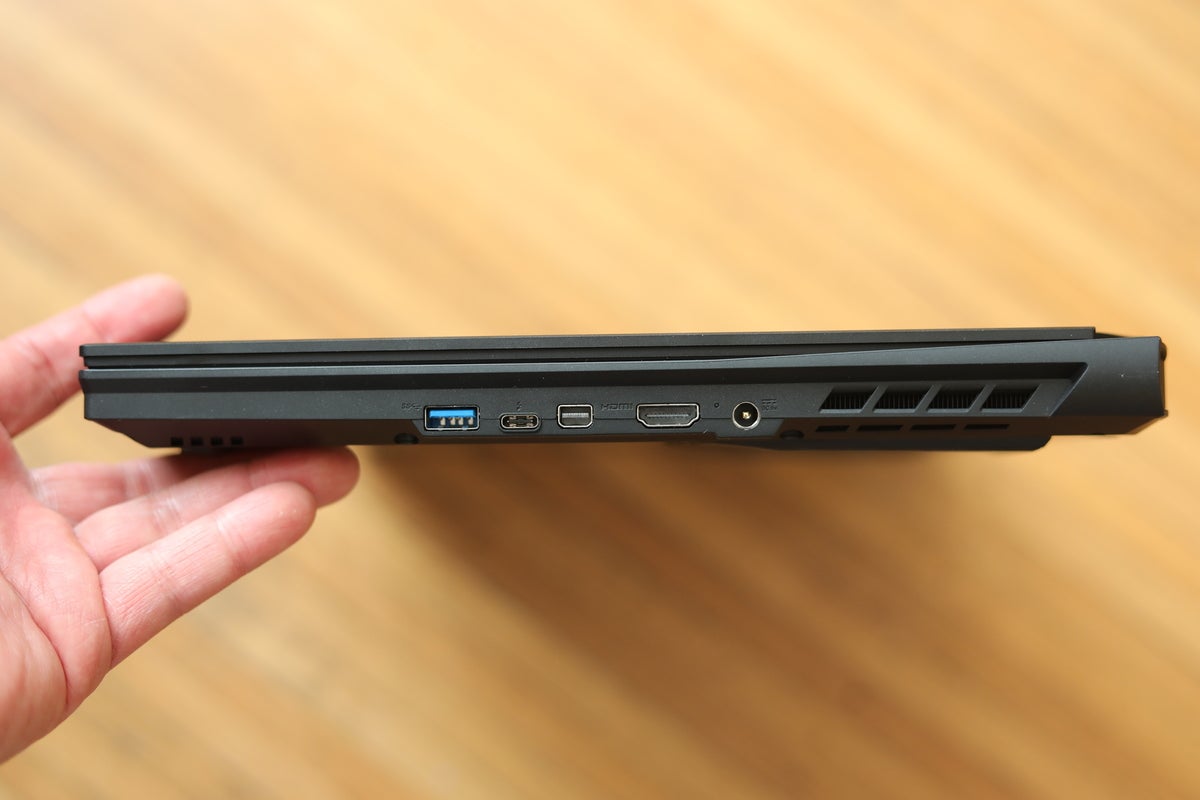 Gordon Mah Ung
Gordon Mah Ung A couple of nice features you don't witness as much these days are the congested-size HDMI 2.0 and the miniDisplayPort 1.4 port. Patc the Thunderbolt 3 left is hooked adequate to the Intel integrated nontextual matter, the HDMI and miniDisplayPort are plumbed directly to the GeForce RTX 3080 board. That won't interest many, but for VR users it's a must-have. Elder VR systems use HDMI, but newer systems such as Valve's Index command DisplayPort.
We suspect G's CEO is a southpaw, yet, because the power connector for the 230-watt brick is on the right sidelong, which is sure to wrath right-handed gamers. Fortunately, Gigabyte uses a cable with a 90-academic degree bending, so information technology's non overly intrusive.
Keyboard and trackpad
The trackpad on the Aorus 17G is a glass-smooth softly hinge design, meaning it's hinged nigher to the keyboard and harder to depress in that area. It features an joint Windows Hello fingerprint reader and is Microsoft Precision Touchpad-manipulable. The trackpad seem a bit small for the size of the laptop computer, but IT worked adequately.
GB builds in some productivity with a 10-key numerical keypad and large, inverted-T cursor keys. Those trained in the dark art of accounting should note, however, that the ten-key uses the telephone layout, rather than the more useful calculator layout that would put the '0' key below the '1.'
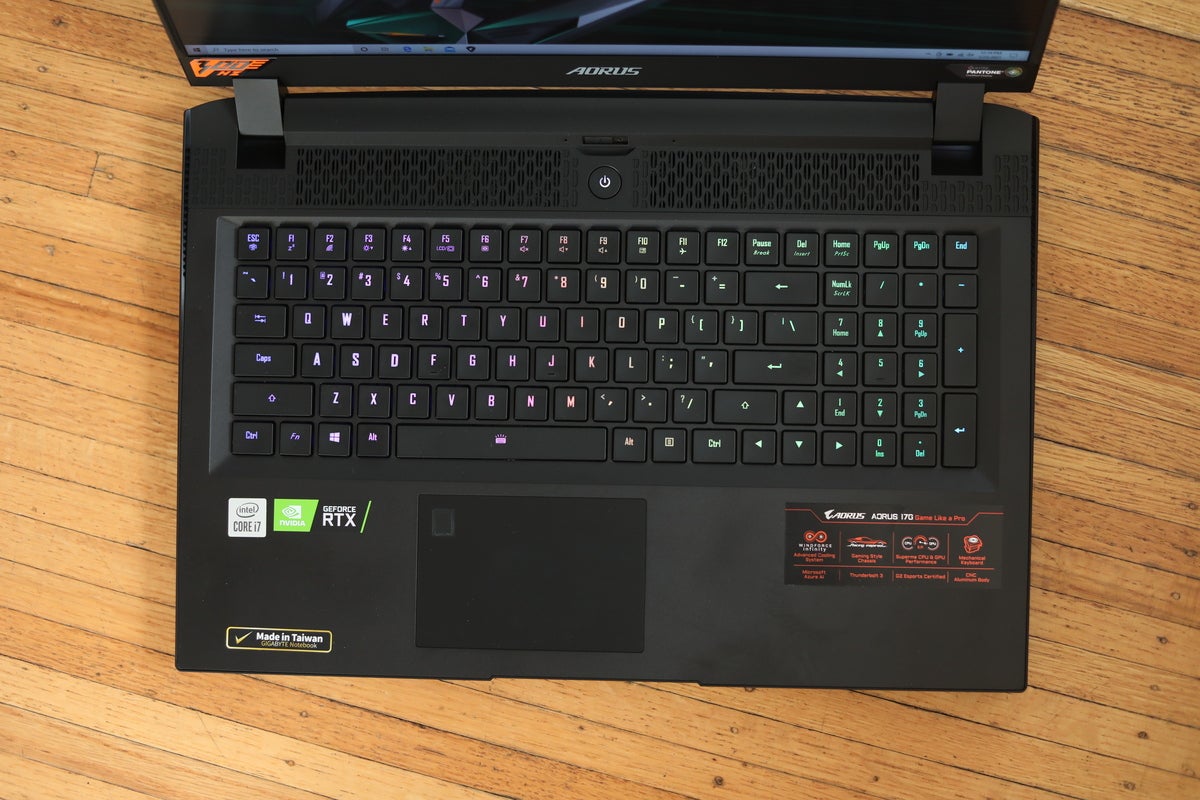 Gordon Mah Ung
Gordon Mah Ung The per key RGB keyboard features Omron mechanic switches happening the Aorus 17G.
The keyboard features per-key ignition and Omron mechanic switches, which offer a nice, wide 2.5mm of move back and a 1.6mm actuation place. Many believe that mechanical switches work better for gaming, but in some case the clicky sound of the Omron switches in the Aorus 17G brought joy to our ears. They sound and feel crisp, with a nice snap every bit they release.
Speakers and webcam
The camera is a pretty distinctive 720p resolution, with a natural science slide cover and average image quality. It is, however, mounted below the CRT screen, which gives your colleagues a with child view of your nostrils and double chin.
The speaker quality is improve than we've detected in thin-and-weak gaming laptops, but that's not saying much. Still, the fact that you can hear these thusly-so speakers terminated the fans is a victory for the Aorus 17G. Speech production of which…
 Gordon Mah Ung
Gordon Mah Ung Why the Gigabyte Aorus 17G is thusly quiet
Gaming laptops have a reputation for being colorful, because it takes a lot of cooling system to keep a hardworking CPU and GPU in line during intensive gaming. Those chilling systems wealthy person tended to rely hard on fans to earn coolheaded publicize and thrust out hot air, and those fans can vex loud. That's why the Gigabyte Aorus 17G's hushed tones are so surprising—and why we had to deal a nigher look.
We set the laptop's GPU to its "Boost" setting, which runs it harder than stock, and left the Processor on its normal profile, and then ran 3DMark's stress test along the Aorus 17G. We rhythmic intelligent with our calibrated effectual level measure placed at a 45-stage angle, two feet from the laptop's hinge. That's roughly head height.
We typically gallus our ears for the shrieking sounds after 10 operating theatre 20 minutes of a graphics load. The fan do kick on with the Aorus 17G, simply the interference never climbs above 38 dB. We could coil 3DMark Time Spy 40 times or 100 times, and it would not change.
Because the ambient room temperature matters, note that near of our examination was conducted in a room whose temperature ranged from 70 to 74 degrees Fahrenheit. On an 85-commencement day we suspect the Aorus 17G might make a trifle noise, but other laptops we tested in the same clime kicked their fans connected out-of-the-way louder most immediately. For comparing, the Asus ROG Flow X13, which is actually quieter than most laptops with its custom RTX 3080 eGPU setup, pushed 48 dB.
Gigabyte achieves the quietness by pairing the 8-CORE Heart i7-10870H with a lower Total Artwork Power (TGP) of 105 Watts for the GeForce RTX 3080 GPU. Laptop vendors can custom-make the TGP, and we've seen most in the 155-Watt stove. Using a lower-world power RTX 3080 means surrender some performance, but how much is the question.
Gigabyte Aorus 17G CPU Performance
First, we'll view the CPU performance. Intel's 10th-gen Core i7-10870H is still reinforced on the company's ancient 14nm process, but among Intel's 8-core laptop CPUs information technology's actually a bad good partially. On paper, it's au fond the draw close-same of Intel's previous uppermost-end Core i9-9980HK chip, with a 5GHz hike clock.
Such of the luster of Intel's H-class chips has faded with the appearance of AMD's Ryzen 5000 chips, which at last add up with high-end GPU options. You can see that down the stairs in the results spurting Maxon's Cinebench R15 on various laptops. Cinebench is a 3D modelling test, and the multithreaded test favors chips with more CPU cores. While the Ryzen 5000-high-powered Asus ROG Flow X13 takes the prize, the Aorus 17G's performance is stillness quite good. In fact, it's very close to the much bigger and much heavier (11-pound) Acer Predator Helios 700, just above it in the graph.
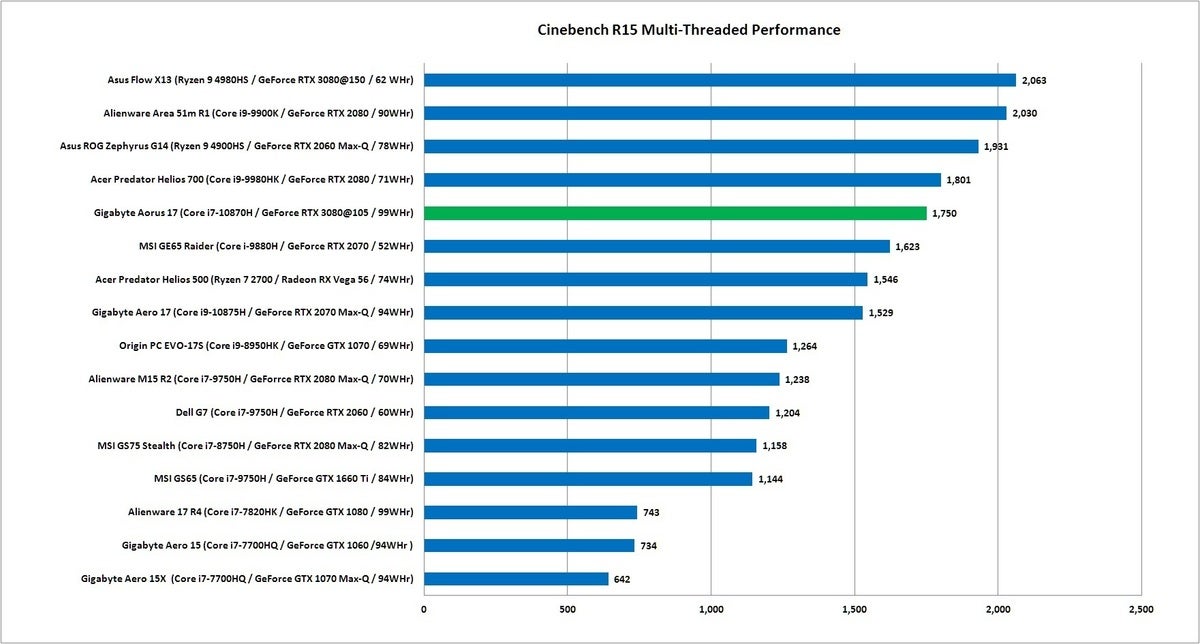 IDG
IDG The Gigabyte Aorus 17G posted a solid score in Cinebench R15's multithreaded test, sticking close to laptops much larger and heavier. Longer parallel bars argue better performance.
We also run Cinebench using a single thread to gauge performance in the majority of mainstream applications that use only one CPU core. Other than the newest Ryzen 5000 chips, most of these laptops declension in circumferent to one another, with small differences you'd probably ne'er comment.
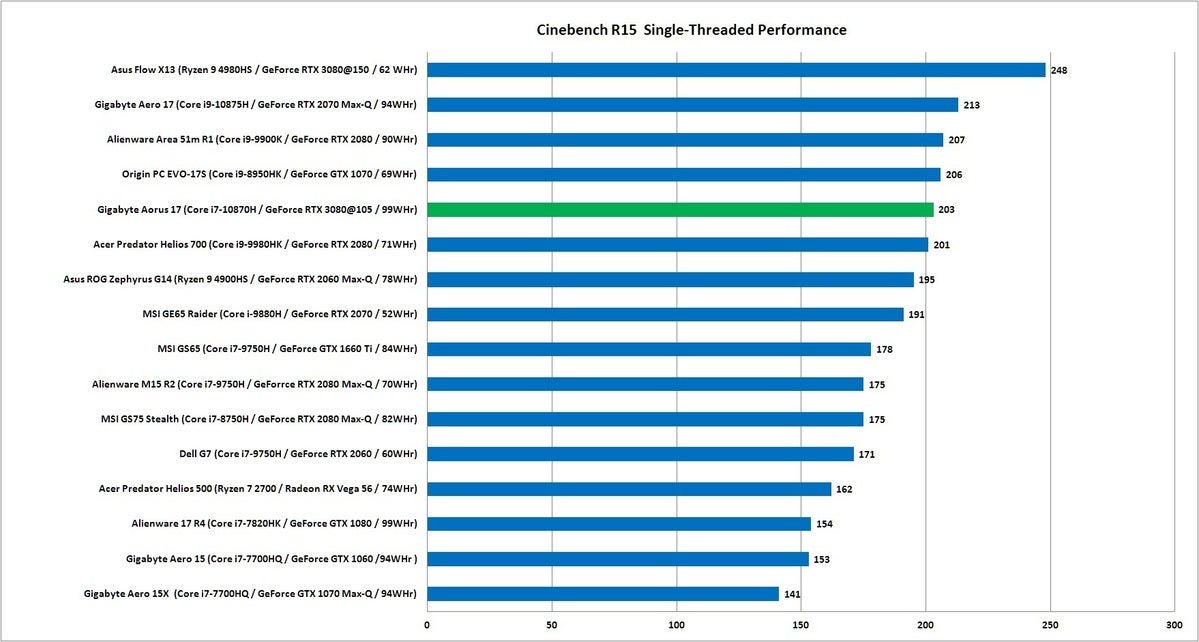 IDG
IDG In single-rib performance, the Gigabyte Aorus 17G again falls near the front of the pack. Longer parallel bars indicate better performance.
Our last CPU-focused test uses the free HandBrake usefulness (version 0.9.9) to try the CPU connected a long-running task—transcoding a 1080p 30GB MKV file for use on an Android tablet. The Aorus 17G does healed, nudging right in the lead with the Asus ROG Flow X13 and its 8-core Ryzen 9-5980HS chip. The fastest, of course, is the 8-core desktop CPU in the Alienware Area 51M R1.
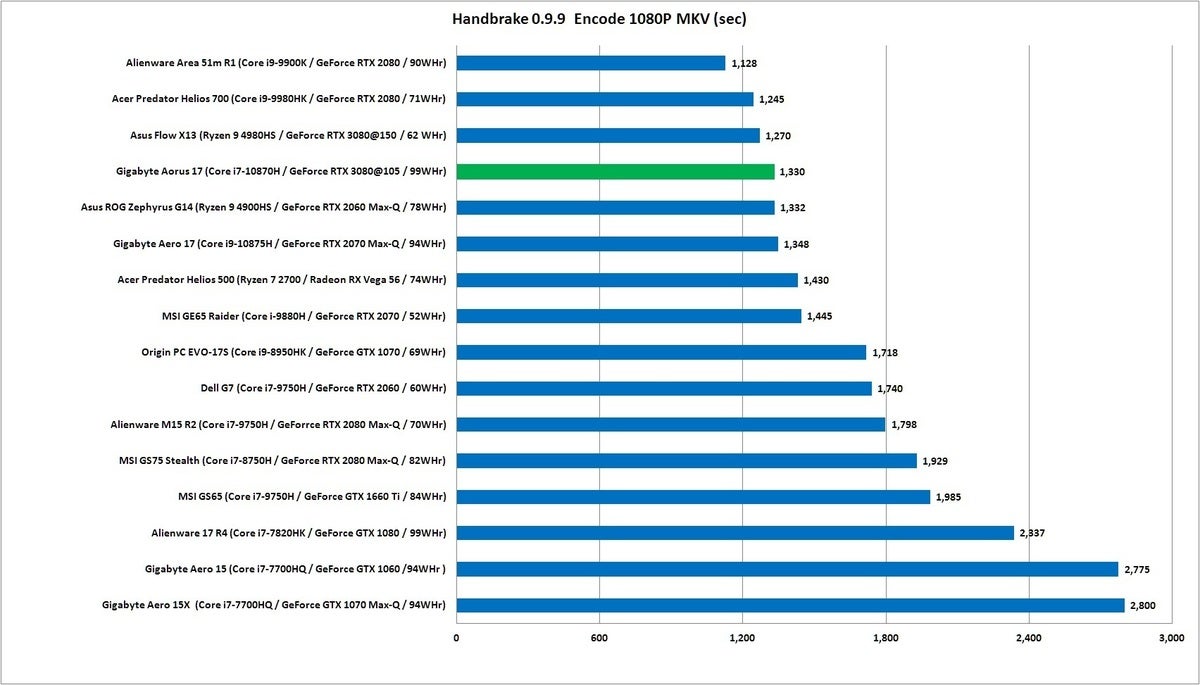 IDG
IDG The Gigabyte Aorus 17G again posts one of the best scores, and in one of our most thermally trying tests, a tribute to its skillful balance of performance and heat make. Shorter parallel bars are better.
What almost gaming performance? Find unsuccessful on the next page.
Gigabyte Aorus 17G Gambling Functioning
Because most people who buy the Gigabyte Aorus 17G will use it for play, graphics benchmarks issue even more. Up first is UL's 3DMark Time Spy. IT's a synthetic examination—meaning it's non an actual game—but information technology's well-respected. Many overclocking contests use of goods and services 3DMark Eastern Samoa a standard of measurement because of its reliability.
Unlike an in-gage benchmark, you can mostly separate CPU performance from GPU performance in 3DMark. That should assist if you'atomic number 75 inquisitive how much you spare on the 105-James Watt TGP RTX 3080 in the Aorus 17G, compared to a laptop with a high-wattage version.
You butt construe with that directly below, where the two RTX 3080-based laptops are separated by about 18 pct in performance. The Gigabyte Aorus 17G is actually slightly outperformed by the Alienware Area 51m and the Genus Acer Predator Helios 700—but both are giant laptops jetting the high-wattage versions of their respective GPUs.
 IDG
IDG In 3DMark Time Spy, you john see the difference between the full-caliber, 155-Watt RTX 3080 in the Asus ROG Flow X13 at top, and the moderated, 105-W RTX 3080 in the Gigabyte Aorus 17G, quaternity steps and 18 percent hindquarters. Some scores are very good, though. Longer bars indicate better public presentation.
We also looked at a few games, including Rise of the Tomb Raider running play in DX11 mode at 1920×1080 resoluteness, set to Very High. It's about a immature courageous and in all likelihood getting to be more CPU- than GPU-underage. The Gigabyte Aorus 17G slightly outperforms the Asus ROG Rate of flow X13 and its external GeForce RTX 3080, even though the latter runs at a higher wattage, likely out-of-pocket to limitations with the x8 connection of the external GPU.
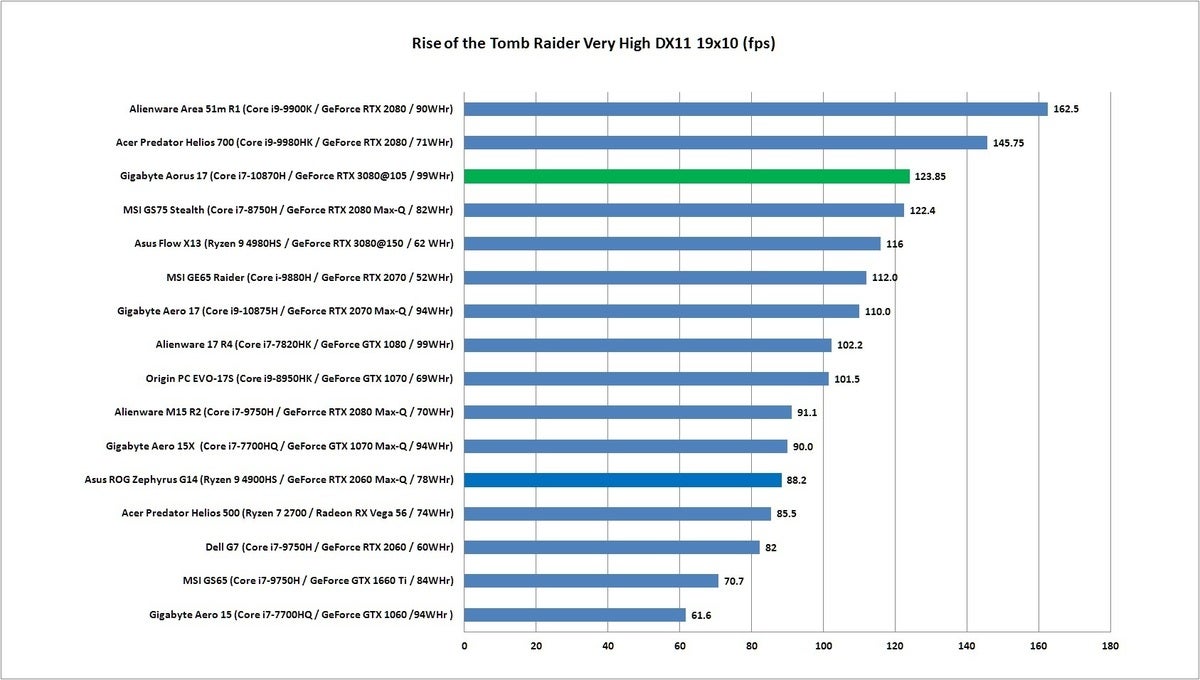 IDG
IDG Here's one gambling benchmark where the Gigabyte Aorus 17G noses extinct the Asus ROG Flow X13, likely because of the last mentioned's external GPU. Yearner bars indicate fitter performance.
Looking toward the future of PC nontextual matter, we used 3DMark's Port Noble test to measure the performance of the Aorus 17G using hardware ray tracing. The Aorus 17G with its much more advanced RTX 3080 easily outperforms some of the high-wattage RTX 2080 GPUs in the much larger laptops. We besides see the Asus ROG Flow X13 and its 150-Watt GeForce RTX 3080 is about 16 percent faster than the Gigabyte Aorus 17G with its 105-watt RTX 3080.
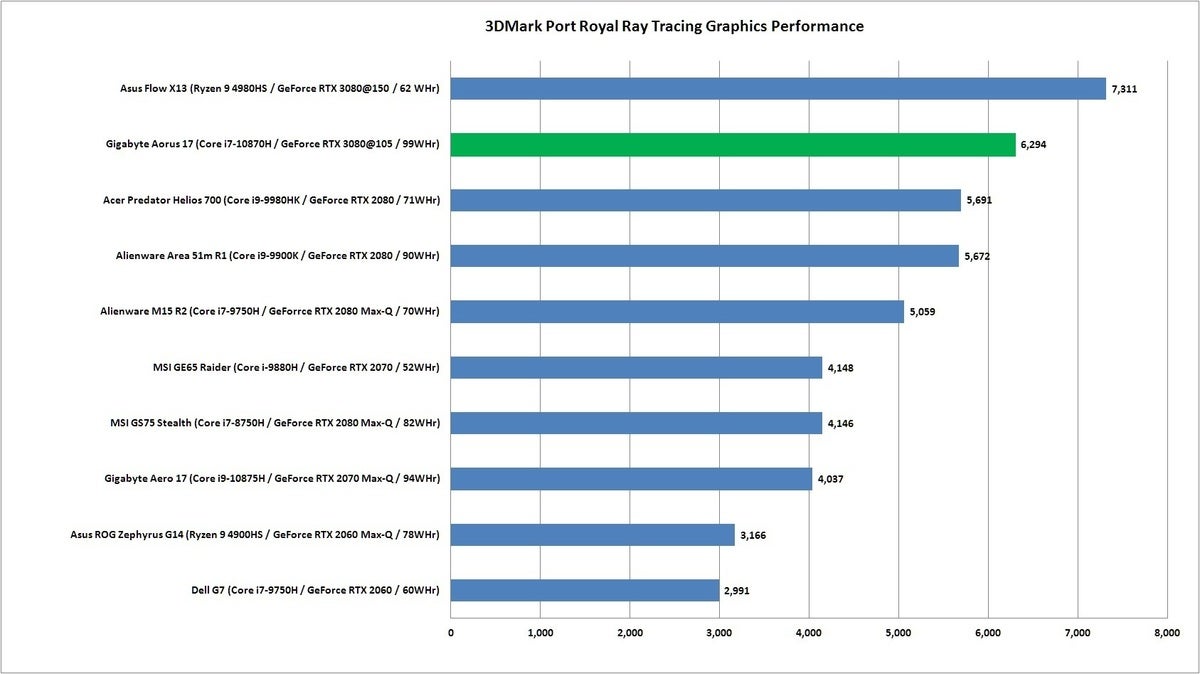 IDG
IDG In 3DMark Port Royal, the Asus ROG Flow X13's full-bore RTX 3080 leads the field, simply the Gigabyte Aorus 17G's qualified RTX 3080 follows with a 16-percent margin. Yearner parallel bars indicate punter performance.
As we said before, if you're into absolute operation needs, you should spit up for a laptop that features a higher-wattage GeForce RTX 3080. Of course, there is a noise cost to the full-bore rendering. The Asus ROG Course X13's external eGPU is quieter than some strange 150-James Watt RTX 3080 laptops we've seen—only it's still about 10 dB louder than the Gigabyte Aorus 17G. To most ears, that's about double the perceived loudness.
Our hold up prove, of battery life story, uses Windows' Movies & TV app to play a 4K video, with the screen adjust at a relatively bright 250 to 260 nits, earbuds connected, and the laptop in Aeroplane mode. The Aorus 17G features Nvidia's Optimus hybrid graphics, which turns off the discrete GPU and passes the work all over to the CPU's much sparing graphics cores. Battery aliveness is just under six hours, which is pretty fair for a laptop with a screen this large and a GPU this regnant.
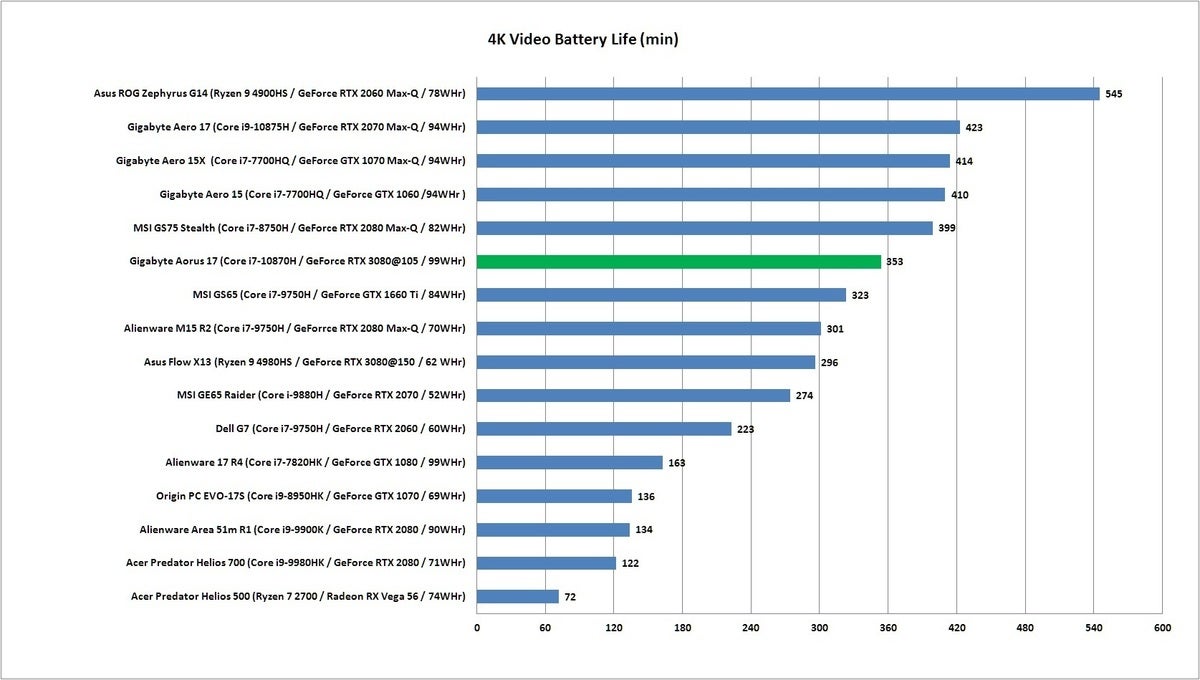 IDG
IDG The Gigabyte Aorus 17G lasted nearly six hours in our battery rundown test, which is really bang-up for a gaming laptop. Longer bars indicate better performance.
Course, video playback is probably one of the easiest things a laptop tooshie do today. Browsing, using Photoshop, operating theater redaction telecasting will reason electric battery life to plump, and games drainpipe the battery most of all. Because most people who game know better than to do it on electric battery, however, the Captain Hicks hours-plus from the Aorus 17G is fine.
Conclusion
Whether the Gigabyte Aorus 17G is the gambling laptop for you mostly depends on how much performance you're willing to ritual killing for peace and quiet. In games, it'll hinge on just how much the game is GPU- operating room CPU-furled. We've seen performance hits from as bantam as 2 percent to as much As 25 percent compared to laptops of similar sized and weight.
For easygoing creation apps, such as GPU-based rendering or compute, the differences between the 155-watt RTX 3080 and the 105-watt RTX 3080 shrink to 10 to 15 percent. That's still a noticeable performance sacrifice, but we empathize if you'll take the tally because your ears send away simply no longer take it. The Gigabyte Aorus 17G is still a very flying gaming laptop, and far from the noisiest, an awfully beseeching combining.
Source: https://www.pcworld.com/article/394065/gigabyte-aorus-17g-review-a-real-gaming-laptop-thats-amazingly-quiet.html
Posted by: petriagge1969.blogspot.com

0 Response to "Gigabyte Aorus 17G Review: A real gaming laptop that’s amazingly quiet - petriagge1969"
Post a Comment